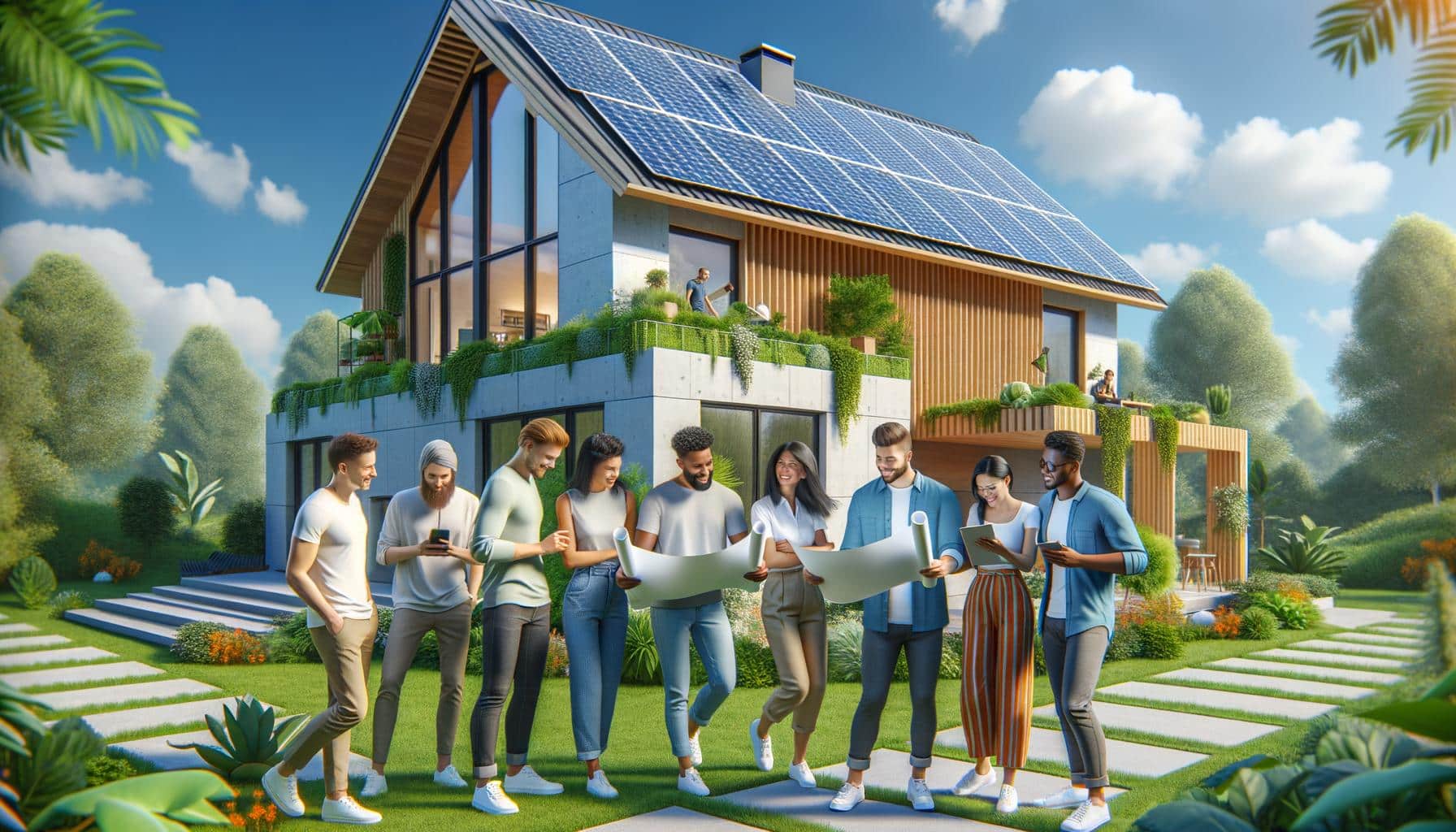
At Home Owners Association, we’ve seen a growing interest in eco-friendly house building plans. The demand for sustainable homes has skyrocketed in recent years, with more homeowners prioritizing environmental responsibility and energy efficiency.
This blog post will guide you through the process of creating eco house building plans that minimize environmental impact while maximizing comfort and efficiency. We’ll explore sustainable design principles, eco-friendly materials, and cutting-edge energy systems to help you build a greener future.
How to Design a Sustainable Home
At Home Owners Association, we understand that thoughtful design can dramatically reduce a home’s environmental impact while enhancing comfort and efficiency. This chapter explores key principles of sustainable home design.
Harness the Power of the Sun
Passive solar design revolutionizes sustainable home construction. Orient your home to maximize southern exposure (in the Northern Hemisphere) or northern exposure (in the Southern Hemisphere) to naturally heat your home in winter and reduce cooling needs in summer. Large, south-facing windows allow sunlight to warm living spaces during colder months, while roof overhangs or adjustable shading devices block intense summer sun.
Passive solar design takes advantage of a building’s site, climate, and materials to minimize energy use. This approach doesn’t require complex technology-just smart planning and strategic window placement.
Keep Cool Naturally
Natural ventilation plays a vital role in sustainable home design. Cross-ventilation, achieved by placing windows on opposite walls, creates refreshing air currents that reduce the need for air conditioning. This strategy proves particularly effective in Australia, where cooling costs can be significant.
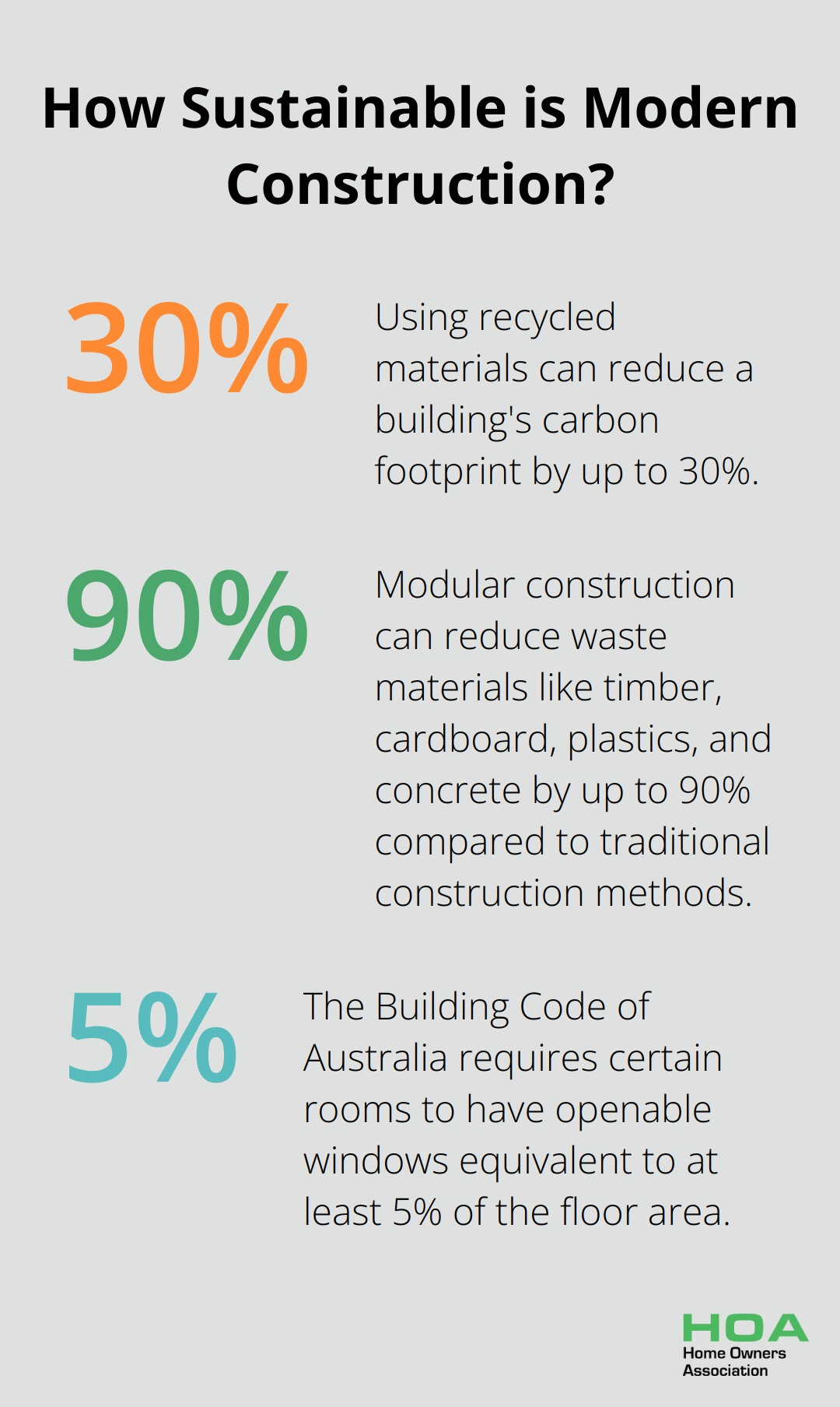
Incorporate features like clerestory windows or a solar chimney. These elements create a stack effect, which draws hot air upwards and out of your home. The Building Code of Australia now recognizes the importance of natural ventilation, requiring certain rooms to have openable windows equivalent to at least 5% of the floor area.
Maximize Space and Materials
Efficient use of space and materials minimizes your home’s environmental footprint. Open floor plans not only create a sense of spaciousness but also improve air circulation and reduce the need for artificial lighting.
When selecting materials, consider recycled or locally sourced options to reduce transportation emissions. Reclaimed wood can add character to your home while reducing demand for new timber. The Green Building Council of Australia reports that using recycled materials can reduce a building’s carbon footprint by up to 30%.
Modular construction techniques significantly reduce waste. These methods allow for precise material calculations and off-site fabrication, minimizing on-site waste. Modular construction can reduce waste materials like timber, cardboard, plastics, and concrete by up to 90% compared to traditional construction methods.
Implement Smart Design Features
Smart design features enhance the sustainability of your home. Try to incorporate:
- High-performance insulation (which can reduce energy consumption by up to 40%)
- Energy-efficient windows (double or triple-glazed)
- Green roofs or cool roofs (to improve insulation and reduce urban heat island effect)
- Rainwater harvesting systems
These features not only reduce your home’s environmental impact but also lead to significant long-term cost savings.
Optimize for Natural Light
Maximizing natural light reduces the need for artificial lighting and improves the overall ambiance of your home. Strategically place windows, skylights, and light tubes to illuminate interior spaces. Consider using light-colored interior finishes to reflect and distribute natural light more effectively.
The next chapter will explore eco-friendly building materials that complement these sustainable design principles, further enhancing your home’s environmental performance.
What Are the Best Eco-Friendly Building Materials?
At Home Owners Association, we notice a significant increase in demand for sustainable construction materials. The selection of appropriate eco-friendly building materials is essential for the creation of a truly sustainable home. Let’s explore some of the top options available in Australia.
Recycled and Reclaimed Materials
Recycled and reclaimed materials offer excellent choices for eco-conscious builders. These materials reduce waste and minimize the need for new resource extraction. In Australia, recycled steel grows in popularity for framing. Reusing steel can make a critical difference in reducing embodied carbon, as steel can be manufactured entirely from recycled scrap/secondary steel.
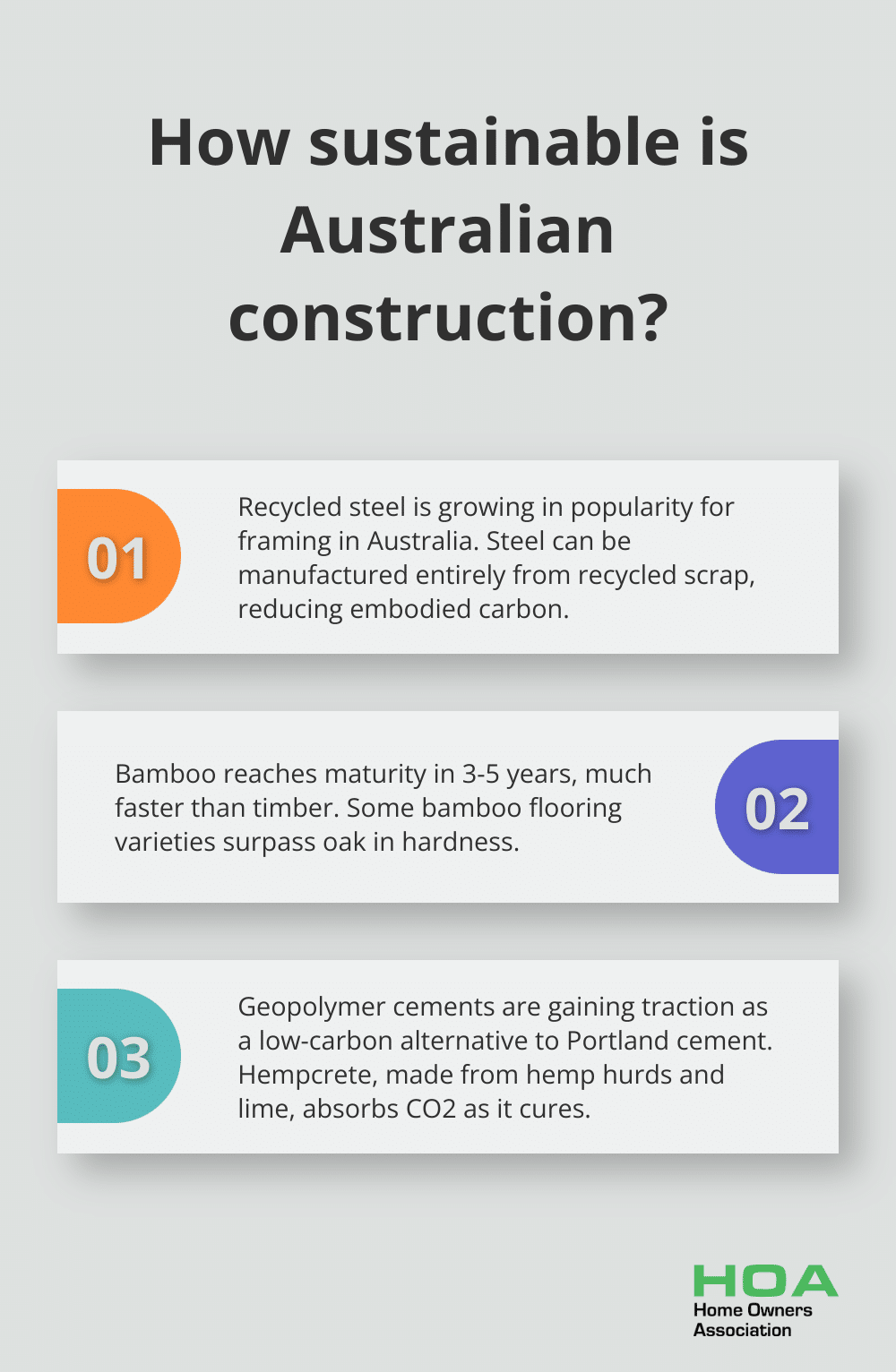
Reclaimed timber presents another fantastic option. It adds character to your home while preserving old-growth forests. Many Australian salvage yards offer high-quality reclaimed wood from demolished buildings. This wood often exhibits more stability and resistance to warping than newly milled lumber.
Sustainable Wood and Bamboo Products
When new wood becomes necessary, select sustainably harvested timber certified by the Forest Stewardship Council (FSC). In Australia, plantation-grown hoop pine and spotted gum serve as excellent sustainable choices for framing and flooring.
Bamboo gains popularity as a sustainable alternative to hardwood. It grows rapidly, reaching maturity in just 3-5 years (compared to decades for most timber species). Bamboo flooring offers durability, with some varieties even surpassing the hardness of oak.
Low-Impact Concrete Alternatives
Traditional concrete production contributes significantly to CO2 emissions. Fortunately, several low-impact alternatives now exist in Australia. Geopolymer cements have emerged as a viable low-carbon alternative to Portland cement. They have already gained traction in Australia and show great potential.
Hempcrete, a mixture of hemp hurds and lime, presents another innovative option. It absorbs CO2 as it cures, making it carbon-negative. Hempcrete provides excellent insulation and naturally resists mold and pests.
Innovative Insulation Materials
Proper insulation plays a vital role in an energy-efficient home. Natural wool insulation, made from excess sheep’s wool, offers an excellent eco-friendly option. It provides renewability, biodegradability, and performs well in Australia’s varied climate zones.
Insulation made from recycled plastic bottles presents another innovative choice. These products divert waste from landfills while providing effective thermal and acoustic insulation.
The selection of appropriate eco-friendly materials marks a critical step in creating a sustainable home. Opting for recycled, reclaimed, and low-impact alternatives not only reduces your environmental footprint but also creates a healthier living space. The next chapter will explore energy-efficient systems and technologies that complement these sustainable building materials, further enhancing your home’s environmental performance.
Powering Your Eco-Home with Efficient Energy Systems
Solar Power Integration
Solar panel installation has become more accessible and affordable in Australia. A 6.6kW solar system can attract a rebate of approximately $2,160 from the Federal government. For optimal performance, north-facing panels should be tilted at an angle equal to your latitude. In Sydney, this angle is approximately 34 degrees.
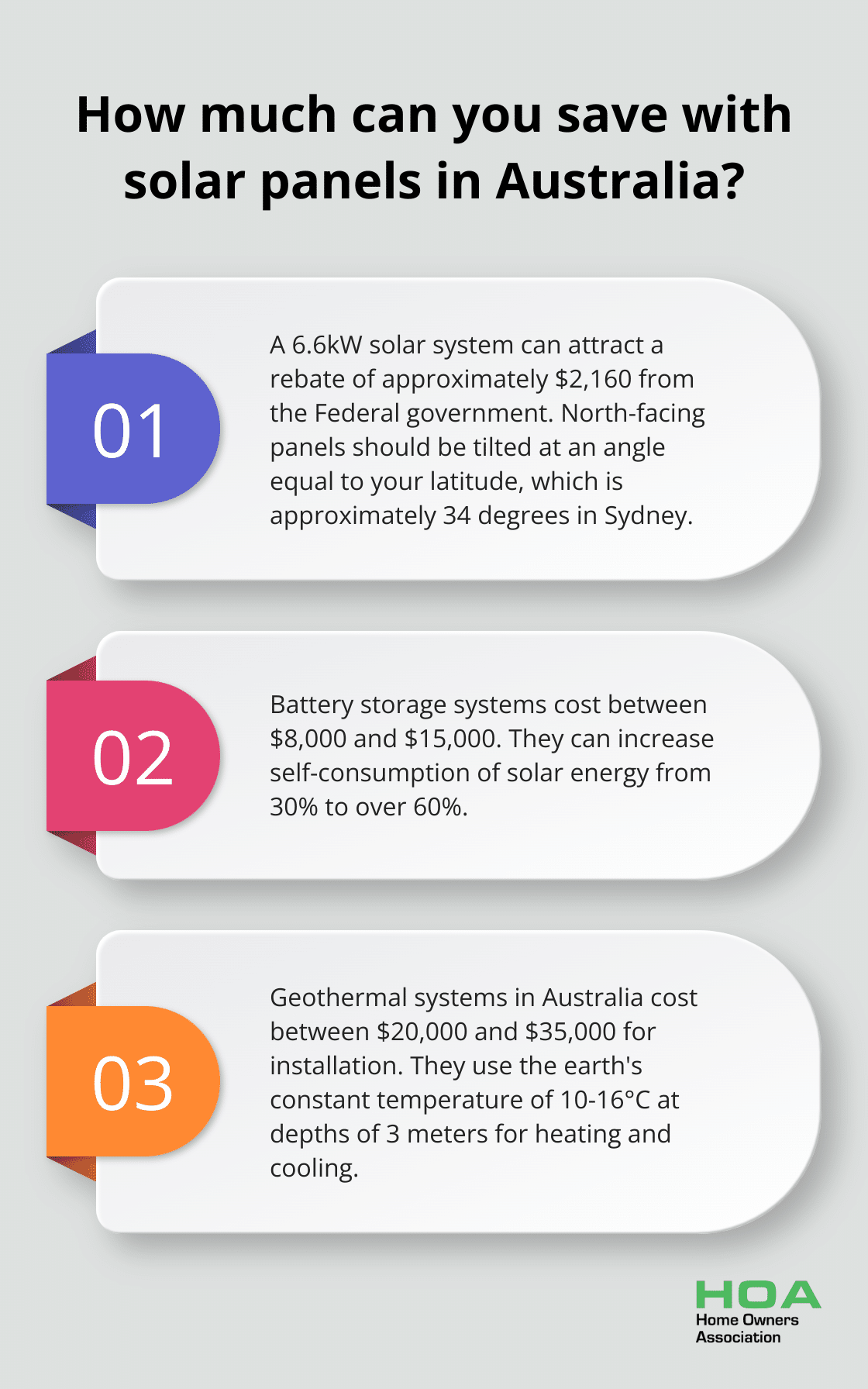
The integration of solar panels with battery storage systems (like the Tesla Powerwall) allows homeowners to use solar energy even during non-sunlight hours. While a battery system costs between $8,000 and $15,000, it can increase self-consumption of solar energy from 30% to over 60%, which maximizes your investment.
Geothermal Heating and Cooling
Geothermal systems offer impressive efficiency, although they are less common in Australia. These systems use the earth’s constant temperature (around 10-16°C at depths of 3 meters) to heat homes in winter and cool them in summer. Installation costs range from $20,000 to $35,000, but they can significantly reduce energy costs.
In Australia, horizontal loop systems are more prevalent due to lower installation costs. Vertical systems may be necessary for properties with limited land area. It’s important to work with a certified geothermal installer to ensure proper system sizing and installation.
Smart Energy Management Technology
Smart home technology optimizes energy use effectively. The Australian smart home market is projected to reach $5.3 billion by 2027, with energy management systems at the forefront. These systems can reduce energy consumption through intelligent control of heating, cooling, and lighting.
Key components of a smart energy management system include:
- Smart thermostats: These devices learn your habits and automatically adjust temperature settings.
- Energy monitoring devices: They provide real-time data on energy consumption, which helps identify energy-hungry appliances.
- Smart plugs and switches: These allow remote control and scheduling of appliances.
- Automated blinds and curtains: They work in tandem with your HVAC system to optimize natural heating and cooling.
When you select smart home devices, look for those compatible with major platforms like Google Home or Apple HomeKit for seamless integration. Also, prioritize devices with high energy star ratings to maximize efficiency.
Professional Installation and Planning
The implementation of these energy-efficient systems requires careful planning and often professional installation. However, the long-term benefits in terms of reduced energy bills and environmental impact make them worthwhile investments for any eco-conscious homeowner.
Final Thoughts
Eco house building plans transform the future of sustainable living. These plans harness passive solar energy, implement natural ventilation, and integrate cutting-edge energy systems to minimize environmental impact. Homeowners who adopt these practices can expect reduced energy bills, improved indoor air quality, and a smaller carbon footprint.
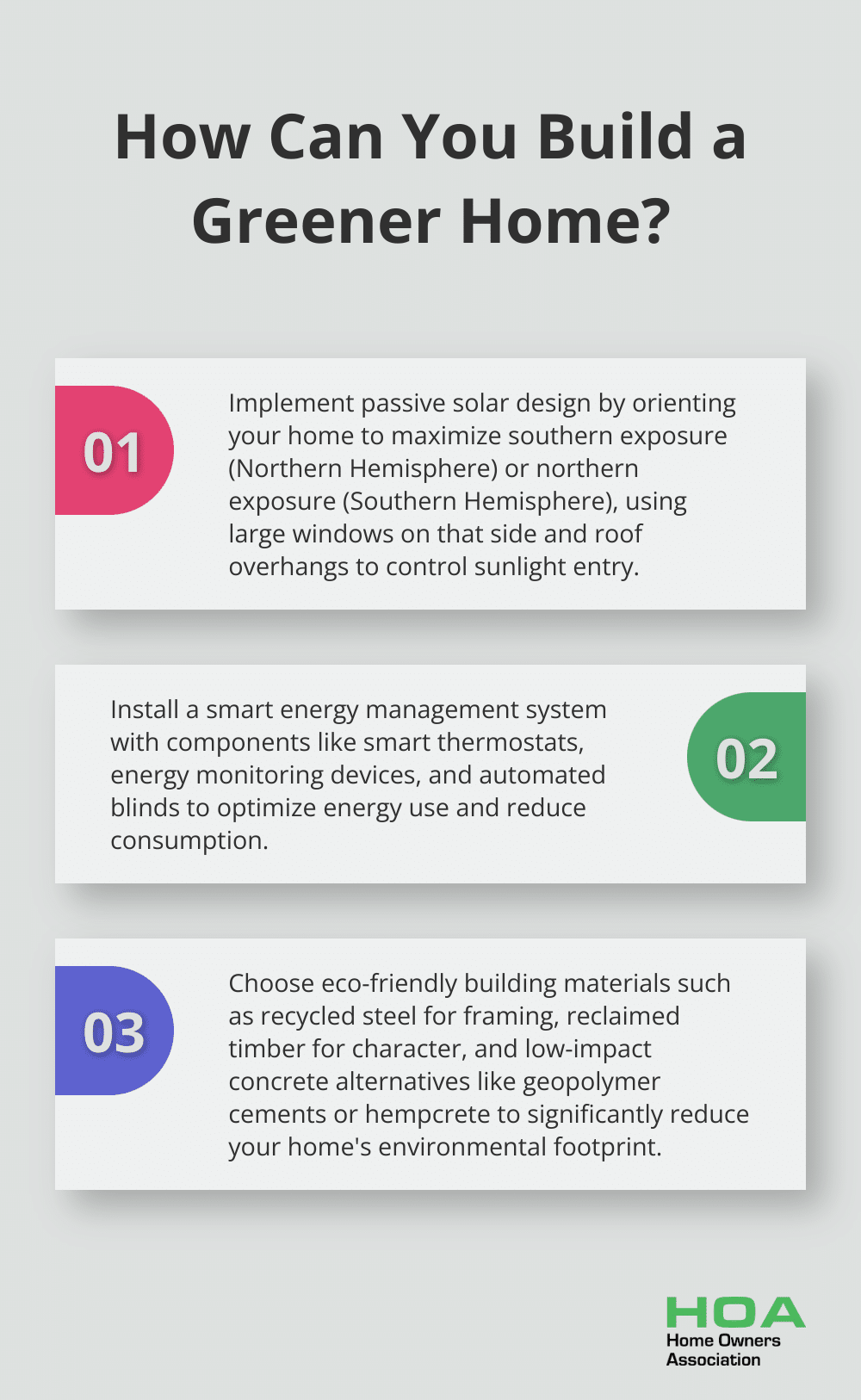
The construction industry evolves rapidly, with sustainable practices becoming the new standard. Eco-friendly homes often command higher resale values, making them a wise investment for the future. These principles pave the way for a greener, more resilient built environment that benefits both individuals and the planet.
Home Owners Association supports Melbourne homeowners in their journey towards sustainable living. We provide resources, expert advice, and exclusive benefits to help navigate the complexities of eco-friendly home construction and renovation. Every sustainable choice contributes to a larger positive impact, actively shaping a more sustainable future for generations to come.





